

Explore the history, culture, people and beautiful landscapes of Vietnam on the 63Stravel travel app
Download the 63stravel app

Can Tho is not only famous as the tourist center of the West, but also attracts tourists with its diversity of tourism types, thanks to its intricate river system and rich land. Let's explore tourist destinations in Can Tho with 63Stravel.com with interesting experiences!
Top 26 extremely HOT tourist destinations in Can Tho that cannot be missed
Immediately save the tourist destinations in Can Tho below to have a wonderful trip to the Mekong Delta.
9 Hong fruit garden
Address: No. 398, Group 31, My Nhon, Phong Dien, Can Tho
The West always attracts tourists with its lush fruit gardens and Can Tho is a destination not to be missed when it comes to garden experiences. At Chin Hong fruit garden eco-tourism area, for only 20,000 VND, you will be able to explore a 13,000m² garden full of green, where you can pick and immediately enjoy fresh fruits like rambutan. rambutan, star apple, Ha Chau strawberry, plum...
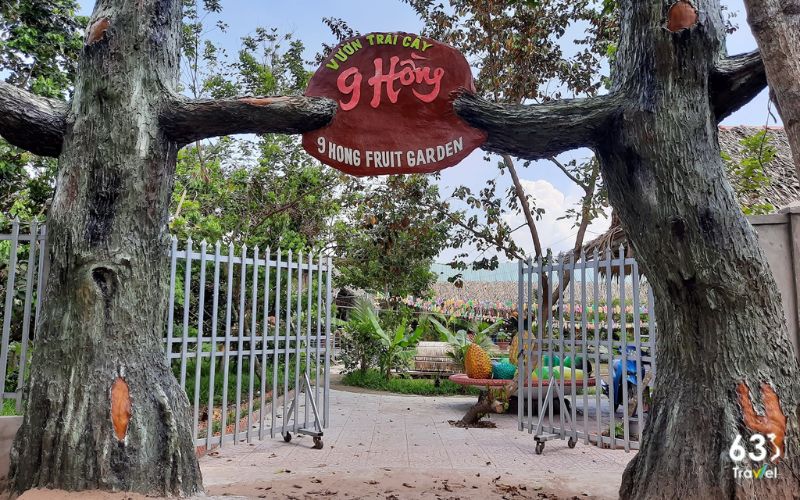
When returning to Tay Do, remember to visit 9 Hong Can Tho Fruit Garden
In particular, the peaceful space with small canals covered with green water hyacinths creates a poetic scene, ideal for those who love taking "virtual life" photos. In addition to freely enjoying fruit, visitors also have the opportunity to participate in many interesting activities such as fishing, boat racing or rope swing.
This is an opportunity to experience authentic garden life and enjoy relaxing moments in nature. Don't forget to end the trip by enjoying Southern specialties such as grilled snakehead fish, fish sauce hotpot or crispy pancakes - the rich flavors of Tay Do land.
Con Au
Address: Hung Phu, Cai Rang, Can Tho
Con Au is an attractive destination in Can Tho, standing out with its rustic beauty and gentle river space. Located in the middle of the Hau River, this tourist area has an area of about 130 hectares, an ideal place to explore lush green gardens filled with fruit and experience the peaceful life of nearly hundreds of households living along the river.
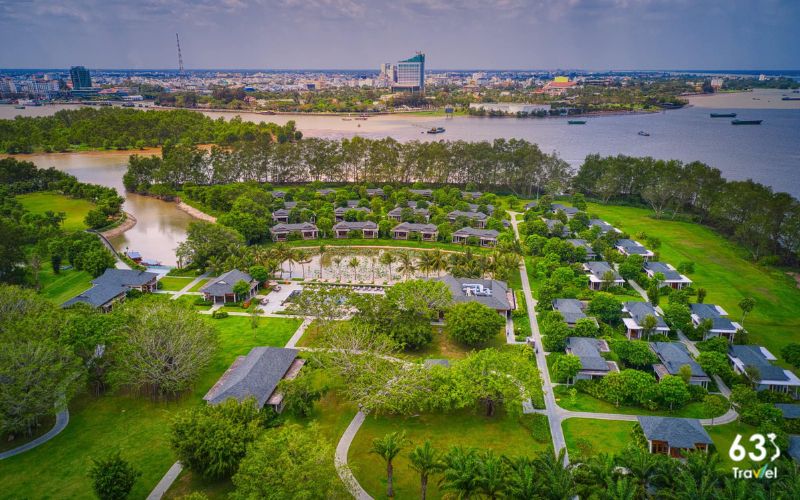
Con Au in Can Tho - immersed in peaceful, poetic beauty
Coming here, you will admire the pristine natural scenery with green cork forests, feel the peace through cool tree-lined paths. You can float down the water on a dinghy, weave through mangrove forests with ancient beauty, or join the people in harvesting vegetables and fruits in the early mornings full of life. Not only that, this place is also an ideal meeting place to participate in folk games and explore the typical lifestyle of the Western river region.
Con Son
Address: Con Son, Bui Huu Nghia, Binh Thuy, Can Tho
In addition to Con Au, Con Son is also a unique tourist destination in Can Tho, having become a favorite stop for families thanks to its peaceful countryside atmosphere and famous specialties such as folk cakes, Delicious fresh fish and shrimp with countless tropical fruits. Not only attracting domestic tourists, Con Son also makes a strong impression on international tourists, typically British billionaire Joe Lewis - owner of Tottenham Hotspur football team, visited this place during his trip to Can Tho in September. June 2019.
Known as one of the rare places that truly implements the spirit of "eco-tourism", Con Son gives visitors the opportunity to immerse themselves in the simple life of local people. Here, you will be able to chat, listen to stories about Western life, participate in cooking yourself, and freely explore fruitful fruit gardens such as grapefruit, mangosteen, star apple, and rambutan. This experience will bring you authentic moments, hard to find anywhere else, true to the rustic West and rich in identity.
Truc Lam Phuong Nam Zen Monastery
Address: My Nhon, My Khanh, Phong Dien, Can Tho
Truc Lam Phuong Nam Zen Monastery in Can Tho stands out with its architecture bearing the imprint of the Ly - Tran dynasties. Built from traditional materials such as Chinese brick, gray block stone and rare elm wood. Although only completed in 2013, the project still exudes a rare ancient look with delicate details such as the Dharma wheel and artistically curved red tile roof.
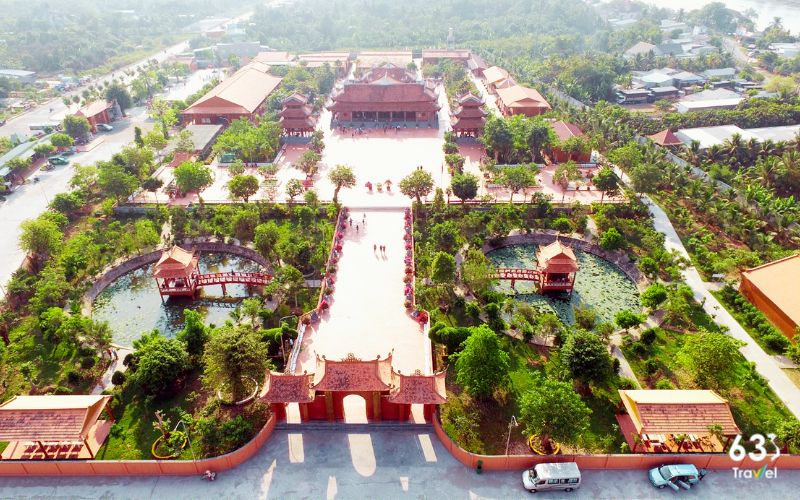
Truc Lam Phuong Nam Zen Monastery - Spiritual tourist destination in Can Tho
Favorite check-in corners here include the majestic three-entrance gate, the quiet lotus pond and the elegant main hall area, creating a space that is both solemn and poetic. With a large, tree-shaded campus, this place brings a peaceful atmosphere, ideal for meditation, prayer or simply relaxing in the natural space.
Ut Hien ecological garden
Address: No. 605, area 4, Ba Lang ward, Cai Rang district, Can Tho
When traveling to Can Tho, tourists often cannot miss Ut Hien - a place that offers unique culinary experiences with all kinds of rustic dishes and famous fresh fruits of the West. More than a stop to enjoy specialties, Ut Hien is also a place where visitors can immerse themselves in the simple life of local people.
With activities such as making folk cakes, catching fish in the pond or experiencing familiar country work. With a green, peaceful space typical of the countryside, Ut Hien is the ideal choice for those who want to find relaxation and quiet, away from the noise of the city.
Muoi Cuong cocoa garden
Address: My Khanh, Phong Dien, Can Tho
When visiting Muoi Cuong cocoa garden, you will be immersed in a peaceful natural space. At the same time, fully experience the exciting cocoa processing process. From hand-picking fresh cocoa beans to watching the meticulous steps to create products such as cocoa powder, chocolate... all bring you a unique and unforgettable experience, helping you You will better understand the journey of creating super attractive drinks from this typical Western fruit.
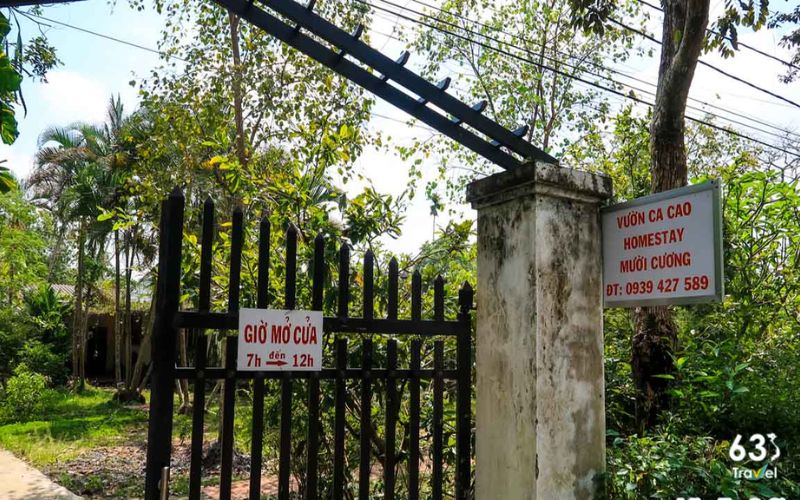
Muoi Cuong cocoa garden - Garden specialty in Can Tho
Buddhist temple
Address: 34 Hoa Binh, Tan An, Ninh Kieu, Can Tho
The Phat Hoc Pagoda was built in 1951 by the Nam Viet Buddhist Association, initially with a simple design with only three floors. However, in the period 2012-2014, the pagoda underwent a major restoration, turning it into a monumental building with five floors, standing out in the heart of Can Tho city. Since its establishment, the pagoda has gone through many generations of abbots, in which Venerable Thich Thien Duc has been attached to and led the pagoda for nearly three decades from 1965 to 1993.
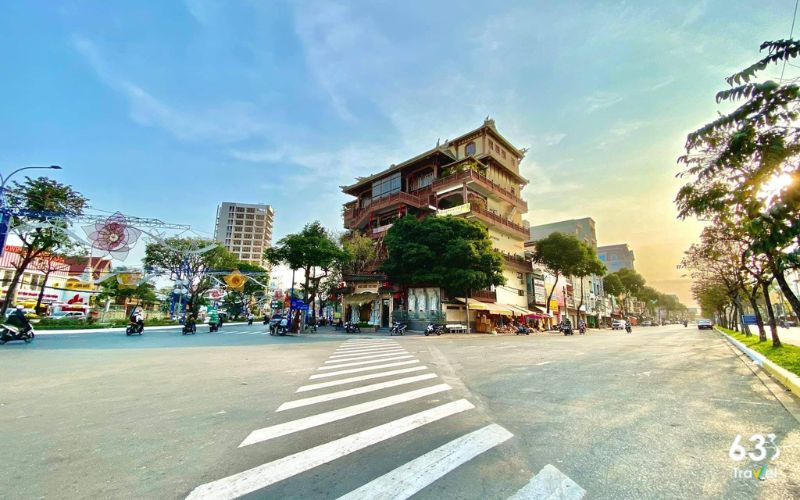
Can Tho Buddhist Pagoda - The most famous pagoda in Tay Do
The uniqueness of Phat Hoc Pagoda lies not only in its majesty but also in its special five-storey architecture, harmoniously combining classic and modern features of the Southwest region. The large main hall is surrounded by rows of green trees, creating a pure and fresh space.
The small three-entrance gate in front, with traces of ancient architecture, is guarded by two statues of Phong Than and Loi Than. On the right are three statues of Amitabha Buddha, Medicine Master and Sakyamuni, along with stones engraved with the Great Compassion Mantra, expressing the wish for peace for passersby.
The space inside the temple is divided into many solemn areas.
The first floor is a place to welcome guests from all over with a space for worshiping and selling Buddhist scriptures.
The second floor is where the majestic Medicine Master Bodhisattva is worshiped.
While the third floor is only open on important holidays such as Tet or Buddha's Birthday
The fourth floor worships Master Bodhidharma.
The fifth floor is where the Western Three Saints are worshiped with Amitabha Buddha in the center.
Ninh Kieu wharf
Address: Tan An Ward, Ninh Kieu District, Can Tho
Ninh Kieu Wharf is considered a brilliant symbol of Can Tho tourism, located on the Hau and Can Tho rivers with a large area of more than 7,000m². This is a rich destination with many attractive functional clusters, including Ninh Kieu pedestrian bridge, Uncle Ho monument, tourist wharf to Cai Rang floating market and Sao Hom restaurant, where you can enjoy the wind. Cool from Hau River.
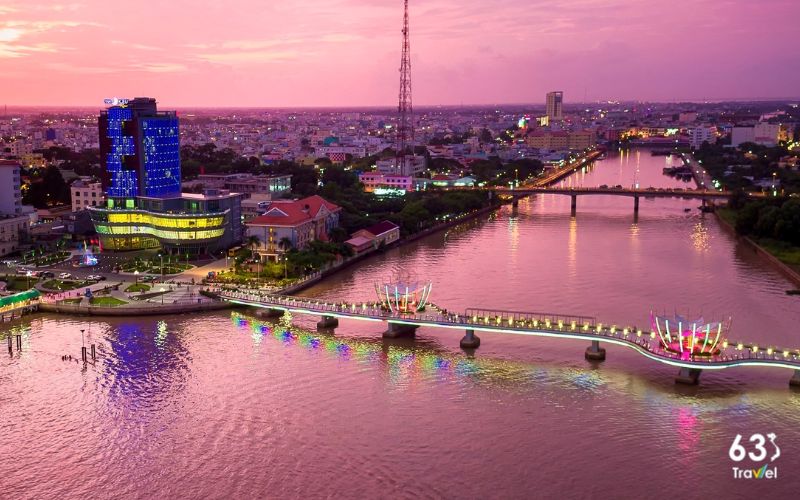
Ninh Kieu Wharf - Admire the beauty of Can Tho river at night
In particular, Ninh Kieu wharf has been planned as a walking city, giving visitors the opportunity to freely explore this lively space. Ninh Kieu Pedestrian Bridge is the first bridge in the Mekong Delta, featuring two lotus stands and covered resting places, along with an LED lighting system using solar energy, creating beauty. shimmering at night.
>> Read more: Revealing 15+ unique historical sites in Can Tho that cannot be missed
Xeo Nhum ecological garden
Address: Hong Loan, Hung Thanh ward, Cai Rang district
Ticket price: 50,000 VND/person
Although it only occupies a modest area of 2 hectares, Xeo Nhum ecological garden still attracts tourists with its convenient location near the city center, appearing in the list of attractive tourist areas in Can Tho. The green space and rich ecosystem, from ornamental plants to fruit trees, create a fresh atmosphere, ideal for those who want to stay away from the hustle and bustle of urban life.
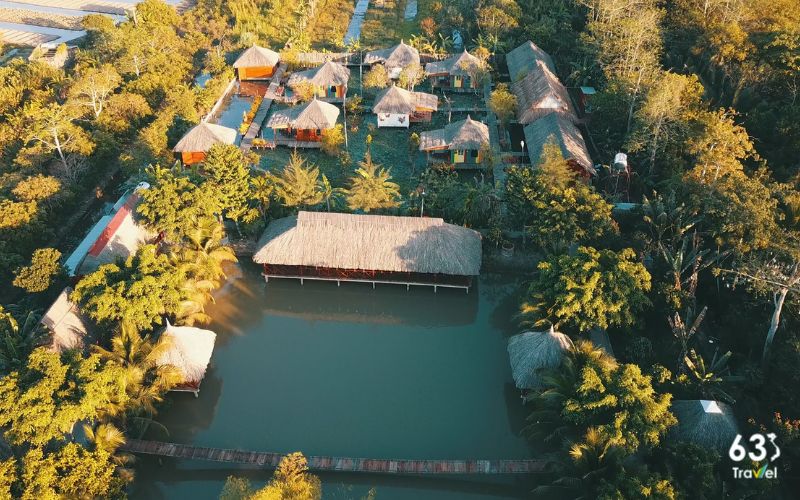
Xeo Nhum Ecological Garden - An interesting garden tourist destination in Can Tho
The unmissable highlight at the garden is the food court, where visitors can enjoy a unique menu with dishes made from "homegrown" ingredients. These fresh dishes not only bring typical flavors of the West but also demonstrate the sophistication of local cuisine.
Can Tho Ong De tourist village
Address: 26 My Ai Hamlet, My Khanh Commune, Phong Dien District, Can Tho.
Ong De Can Tho tourist village is an ideal destination for those who want to explore the garden's ecological space. A place where you can immerse yourself in fresh nature and enjoy dishes with hometown flavors. Here, visitors will experience interesting folk games such as cycling across the plank bridge, crossing the rope bridge and challenging the monkey bridge.
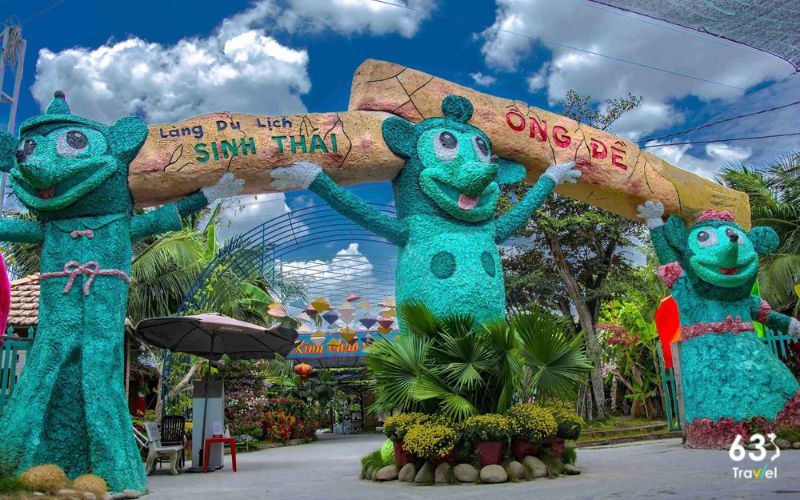
Have fun at Ong De Ecotourism Village in Can Tho
Currently, Ong De eco-tourism area attracts a large number of young people with attractive entertainment activities. You can freely visit the fruitful orchards and take beautiful photos in the peaceful rural space. In particular, the cuisine here cannot be missed; Rustic dishes prepared in a Western style will make you unforgettable.
Kitty & Minnied amusement park
Address: National Highway 1A, Tan Phu Thanh commune, Chau Thanh A district, Hau Giang province
Ticket price: 80,000 VND/person
260,000 VND/person/package
When it comes to tourist destinations in Can Tho, KITTY & MINNIED park is definitely a destination not to be missed for those looking for a modern entertainment space amidst a riverside countryside setting. Here, you will admire world-famous architectural works vividly recreated such as the Leaning Tower of Pisa, the Statue of Liberty, the Arc de Triomphe...
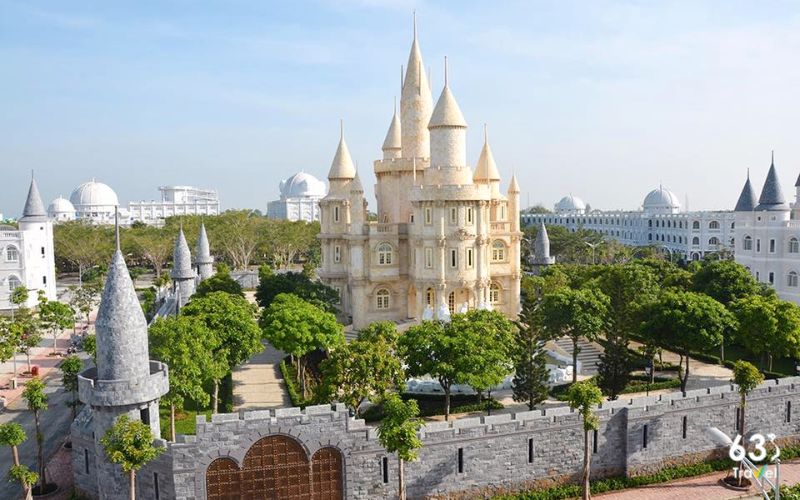
Kittyd & Minnied Park Can Tho - lost in the wonderland of Europe
In addition to sightseeing, visitors also have the opportunity to experience thrilling and challenging games such as speedboats, high-speed ferris wheels, and pirate skills. In particular, the park also organizes attractive performances and street parades with favorite fairy tale characters. One of the most prominent spots is Europe Square, where you can freely take photos next to splendid classic villas, creating memorable memories on your journey to explore Can Tho.
Bao Gia Trang Vien ecological garden
Address: No. 268 Huynh Thi No, Phu Quoi Area, Thuong Thanh Ward, Cai Rang District, Can Tho
Reference ticket price: adults: 100,000 VND/ticket. Children: 70,000 VND/ticket.
Bao Gia Trang Vien - one of the most attractive destinations in Can Tho, stretching over an area of 20,000m² with beautiful natural landscape. Here, visitors can participate in many interesting activities, from individual to group games such as basket boat swimming, car racing, ferris wheel, fishing and wooden bridge riding. In particular, the camping space is ideal for gatherings around the campfire, bringing a cozy experience with family and friends on starry nights.
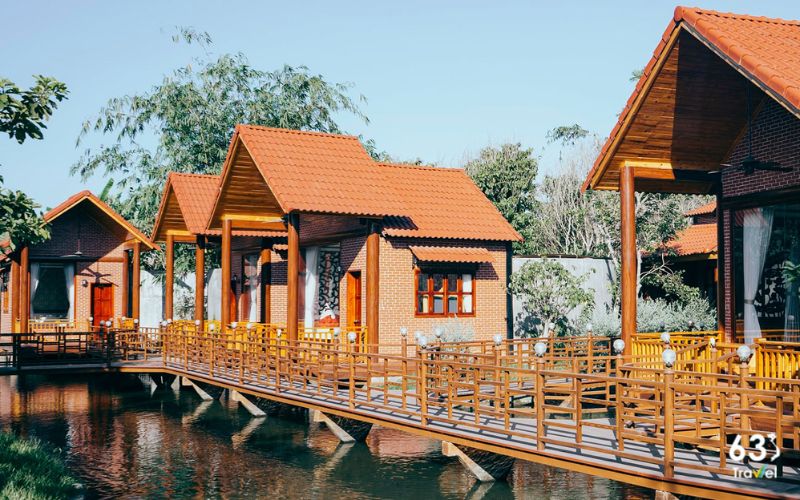
Enjoy the fresh space at Trang Vien Bao Gia Ecological Garden
One of the highlights at Bao Gia Trang Vien is the outdoor climbing challenge with a height of 25m. This is a great opportunity for you to practice endurance and concentration. In addition, bicycle trips around campus not only help you admire the beauty of nature but also improve your physical fitness.
Bao Gia Trang Vien area offers a cool green space, ideal for relaxing moments. With flat and spacious terrain, this is an ideal place for picnics and team building activities, as recorded in many travel guides.
Ong Pagoda
Address: 32 Hai Ba Trung, Tan An, Ninh Kieu, Can Tho
Ong Pagoda (also known as Chinese Taoist Temple or Quang Trieu Assembly Hall) is one of the prominent ancient pagodas in Can Tho. Built by the Chinese community in 1894 and completed in 1986. With the typical red color of Chinese architecture, the pagoda is decorated with delicate gilded lacquer, bringing a feeling of both solemnity and elegance. cozy.
Entering the pagoda, visitors will admire the unique architectural beauty with green tiled roofs and curving dragon sculptures, along with vivid patterned walls. The space inside the pagoda is spacious, highlighted by light wells and formal frescos. The pagoda's architecture is designed in the shape of the letter Quoc, with a typical yin-yang tile roof, creating a perfect blend of antiquity and sacredness.
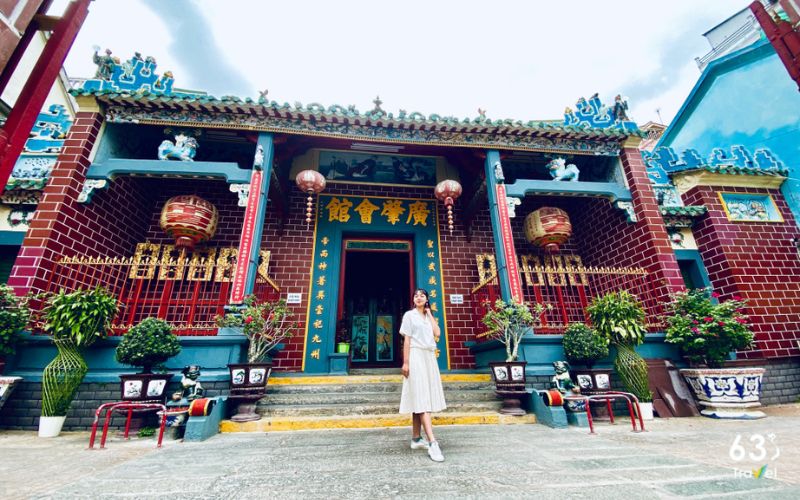
Ong Pagoda in Can Tho - a unique temple of the Chinese people
Although located in the middle of a bustling residential area near Ninh Kieu Wharf, Ong Pagoda still easily attracts attention with its outstanding colors and unique design. This is not only a hot place for Can Tho youth but also a sacred place, attracting those who want to explore the spiritual beauty of the West.
Ong Pagoda carries unique cultural values of the Chinese people. With exquisite patterns and unique architecture, it becomes an outstanding destination, where visitors can immerse themselves in a peaceful space, praying for peace and happiness.
Thot Not lotus pond
Address: Thot Not District - Road to National Highway 91, Can Tho City
One of the highlights that attracts young people of Can Tho is the charming beauty of Dam Sen Thot Not. Images of stretching lotus ponds, glowing under the sunlight and lovely small houses tinged with time, create a lyrical, romantic picture of nature.
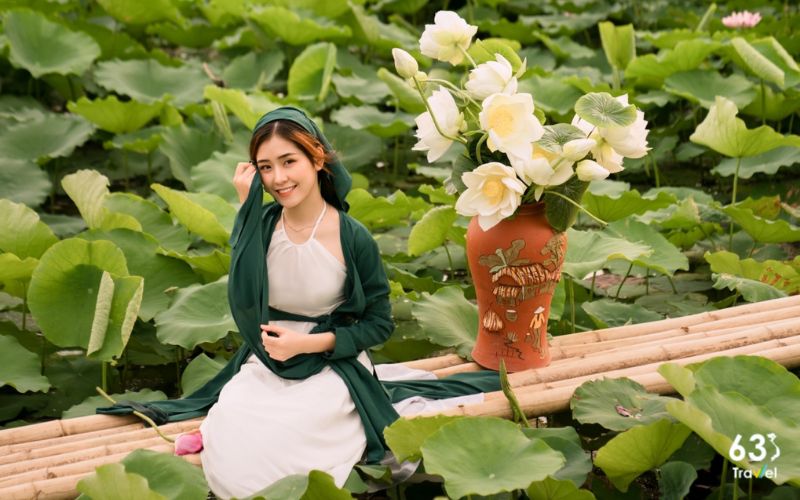
Enjoy thousands of virtual living corners at Thot Not lotus pond
Dam Sen Thot Not is not only an ideal destination for young people but also attracts all ages looking for beautiful moments. With clear blue skies and fresh lotus leaves, this place provides the ideal setting for vivid and poetic photos. In particular, visitors also have the opportunity to take free photos, helping you keep beautiful memories without worrying about costs.
Can Tho love bridge
Address: Hai Ba Trung Street, Ninh Kieu District, Can Tho City.
Can Tho Love Bridge (also known as Ninh Kieu pedestrian bridge), the bridge has quickly become a favorite destination of young people and tourists. Connecting Ninh Kieu Wharf with Cai Khe Islet, the bridge is not only a convenient way but also an ideal place to enjoy the beauty of the Hau River.
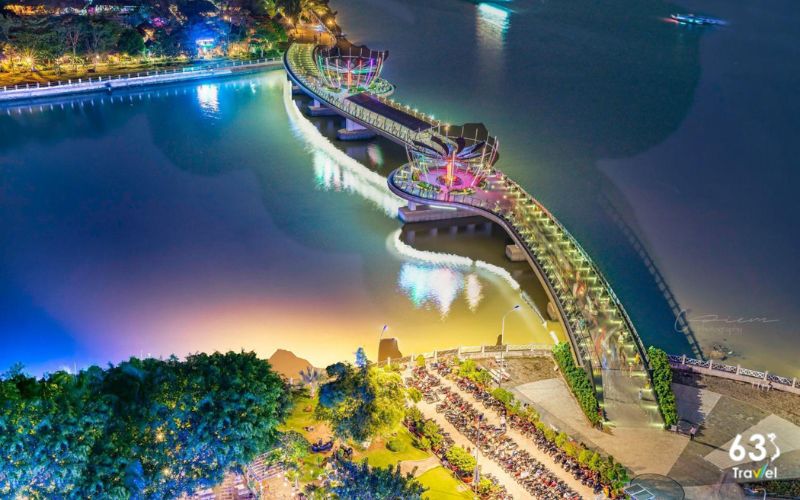
Love Bridge Can Tho - Romantic destination for couples in love
Located near the end of Hai Ba Trung Street and the yacht area, the bridge offers a relaxing experience amidst beautiful natural space. The special thing about Love Bridge is its soft curving design in an S shape, expressing the charm and pride of Vietnamese culture. With a length of nearly 200m and a width of about 7.2m, the bridge is decorated with lotus stations and brilliant LED lights, making this place come alive and sparkling at night.
When walking on the bridge, you will feel the romantic and fresh atmosphere, with beautiful landscapes all around. This is truly an ideal place to watch the brilliant sunrise or enjoy the bustling atmosphere when the street lights up in the evening. Love Bridge is not only an ideal check-in point but also a unique piece in the picture of Can Tho river region.
Cai Rang floating market
Address: Le Binh Ward, Cai Rang District, Can Tho.
Can Tho floating market is located downstream of Can Tho river, only about 600m from Cai Rang bridge, and is one of the destinations not to be missed when setting foot in this land. With a large water surface area, the market becomes a gathering place for about 300 - 400 boats every day, bringing a vibrant atmosphere and vivid colors of river life.
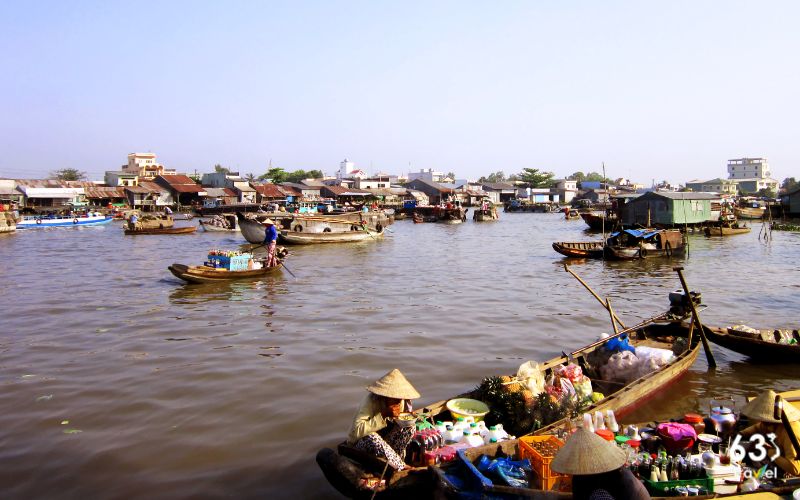
Cai Rang floating market features Western culture that captivates tourists
From 4 to 5 am, the market begins to bustle and as the sun rises, the trading atmosphere gradually calms down. To fully experience the beauty and bustle of the market, come early to feel the hustle and bustle of life on the river. An interesting point is that you can look up at the bamboo trees hanging on the boat to see what items are being sold, from fresh fruit to local specialties.
Not only do you immerse yourself in the bustling atmosphere, you also have the opportunity to watch the beautiful sunrise reflecting on the water, creating a magical scene. Don't forget to enjoy specialties right on the boat, to start the new day completely and deliciously. Can Tho floating market is not only a place to shop, but also a unique cultural experience, reminiscent of the simple and rich life of the people here.
Lung Cot Lau eco-tourism area
Address: Highway 61C, Nhon Nghia commune, Phong Dien district, Can Tho
Ticket price: Free.
Tickets to visit the fruit garden: Adults: 20,000 VND/ticket. Children: 10,000 VND/ticket.
Canoe ticket: 20,000 VND/ticket.
Lung Cot Cau is one of the famous eco-tourism areas in Can Tho, attracting many tourists because of the simple beauty and fresh air of the river region. Here, you will be immersed in beautiful nature, where the history of ancient Funan residents has left its mark for more than 1,500 years.
Lung Cot Cau tourist area offers you countless exciting entertainment activities, helping you and your friends have memorable fun moments. Interesting games such as catching fish, tug of war and going on a monkey bridge without handrails are not only challenging but also bring refreshing laughter, eliminating all fatigue. This is truly an ideal destination for those who want to experience colorful river life and find joy in every moment.
Gian Gua relic site
Address: Nhon Khanh Hamlet, Nhon Nghia Commune, Phong Dien District, Can Tho City.
Gian Gua relic site - an important base of the southern liberation army before 1975. Not only does it impress with its profound historical value but also with the wild and unique beauty of the landscape here. The branches of the trees stretch and intertwine to form cool canopy, while traces of bombs and bullets are still imprinted on the ground, reminiscent of a painful but resilient period.
If you are someone who loves to explore and seek challenges, come here to experience the journey into the ruins. The road to Gian Gua will bring you interesting and memorable moments that you will never forget. Because of this uniqueness, the Gian Gua relic site is always on the list of attractive places for Can Tho youth.
This place not only preserves traces of the resistance war against the French and the Americans but is also a sacred space where you can feel the breath of history and the persistence of nature. Ancient trees grow into sturdy trusses, creating a mysterious and vibrant forest, inviting you to explore and contemplate.
Binh Thuy ancient house
Address: 144 Bui Huu Nghia, Binh Thuy Ward, Binh Thuy District, Can Tho.
When coming to Can Tho, besides interesting experiences at the floating market or Ninh Kieu wharf, visitors cannot miss Binh Thuy ancient house, a building more than 100 years old, outstanding with its unique East-West architecture. unique. Even though it has gone through many historical events, the house still preserves its ancient beauty and was once the setting for the famous movie "Lover".
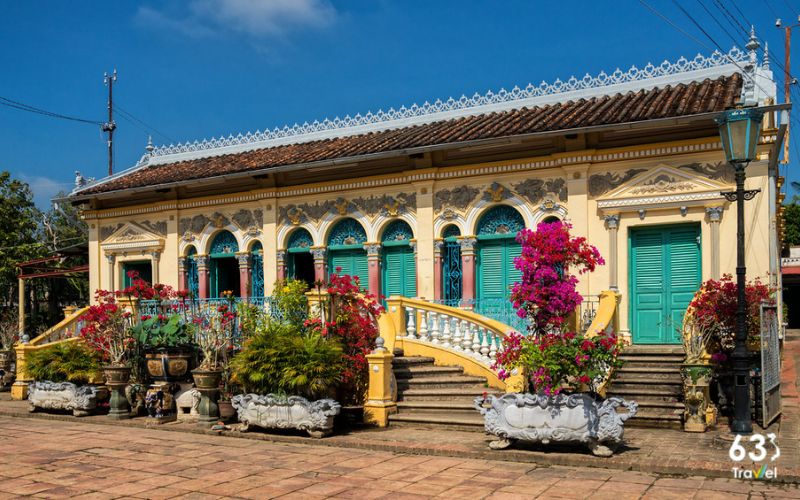
Binh Thuy Ancient House in Can Tho - The most beautiful ancient house in Tay Do
Located in the peaceful space of Tay Do, Binh Thuy ancient house is not only an interesting stop but also a testament to the cultural interference of Vietnam - China - France. The architecture of the house is a blend of three styles, creating a unique beauty that is hard to find anywhere else. Over the years, the house is carefully renovated to preserve its precious historical and cultural values.
Coming here, you will feel the tranquility and antiquity, where time seems to stand still, allowing you to relax and relive the old space. Binh Thuy ancient house is not only an interesting destination but also a place to contemplate and feel the unique cultural beauty of Can Tho.
Bang Lang stork garden
Address: Thoi An Hamlet, Thoi Thuan Ward, Thot Not District, Can Tho.
Bang Lang stork garden attracts tourists because of its peaceful scenery with cool green bamboo rows and fresh countryside air. This place is the home of many species of storks such as flying storks, fish storks, ghost storks and green storks, with a variety of sizes - from tiny storks weighing only about 150 grams to heavy ivory storks and ibises. up to 1.2 kg.
Visiting Bang Lang stork garden is not simply an entertainment activity but also an opportunity for you to explore the beauty of wild nature. Known as the largest bird sanctuary in the Mekong Delta, the stork garden owns more than 300,000 white storks, creating a vivid and poetic picture when they fly in the sky. Coming here, you will feel the spirit of "good land where birds perch," where nature blends with human life in a peaceful and simple space.
My Khanh tourist village
Address: 335 Lo Vong Cung, My Khanh Commune, Phong Dien District, Can Tho
My Khanh tourist village with a large area of more than 30 hectares, is one of Can Tho's prominent destinations, providing a space filled with four-season fruits and flowers. This is not only a resort with luxury bungalows and resorts, but also an entertainment and culinary complex of the Mekong River Delta.
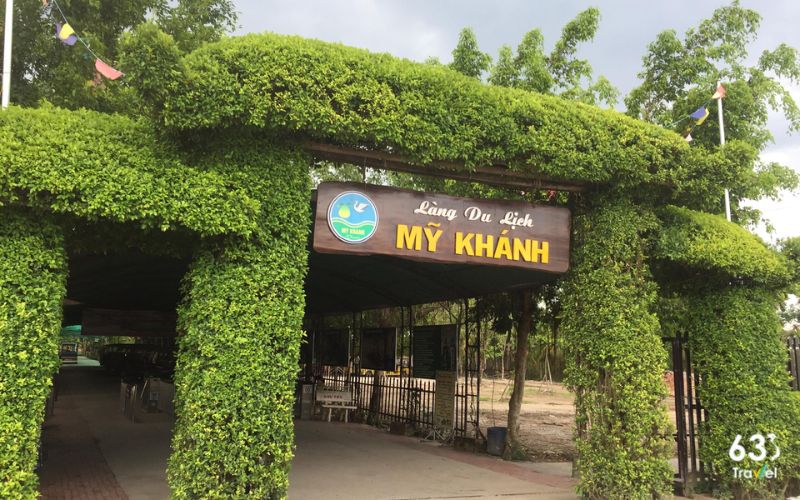
My Khanh Tourist Village - a great destination in Can Tho
My Khanh tourist area is truly a highlight in Can Tho's travel guide, featuring a rich ecosystem and attractive folk games such as dog racing, boating and swinging across ditches. Coming here, you not only have the opportunity to explore nature but also experience interesting activities with friends and family.
The space here is great for taking "virtual life" photos with lush green grounds, fruit-filled gardens and many beautiful corners to preserve memorable moments. In addition, you will enjoy Western specialties such as braised fish, fish sauce hotpot and grilled snakehead fish, creating an unforgettable culinary experience when visiting Can Tho.
Purple house in Can Tho
Address: No. 99 Chi Sinh Street, Tan Phu Ward, Cai Rang District, Can Tho City.
Ticket price for children under 10 years old: 30,000 VND/ticket (Children under 4 years old are free)
Adult ticket price: 60,000 VND/ticket
Located in the heart of Can Tho, Purple House has become a prominent "virtual living" spot, no less than Mural Road. With its characteristic purple color, the house creates a special impression, being both modern and retaining the simple beauty of the West.
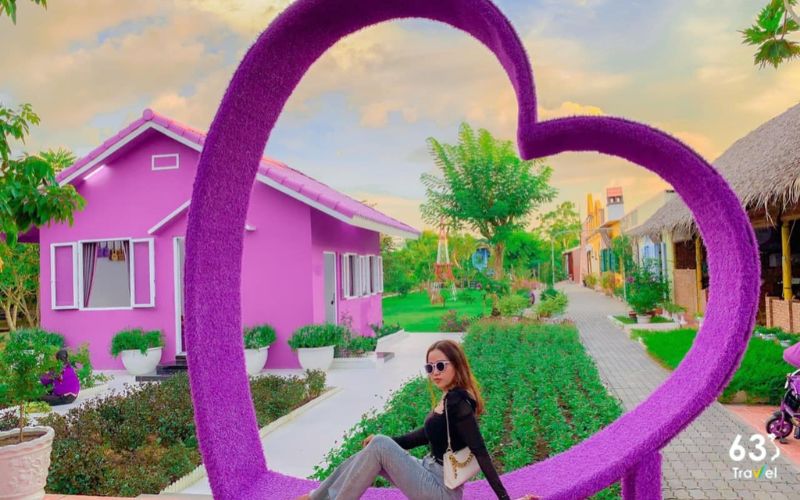
Unique purple house in Can Tho
Built by Huynh Thi Ngoc Sen and her husband, this place carries within it a story of love and fidelity. The couple transformed an ordinary garden into an enchanting romantic space, thanks to their creativity and dedication to every detail.
In addition to other famous tourist destinations in Can Tho, Purple House confidently shines, attracting all eyes. If you are looking for a romantic little corner to capture beautiful moments, this is the ideal choice. When you come here, you will not only enjoy a free drink but also have the opportunity to rent space to carry out art projects such as filming or taking photos.
>> Learn more: Discover 10 traditional craft villages in Can Tho that are famous for their simplicity
Nam Nha Pagoda
Address: 612 Cach Mang Thang 8 Street, Bui Huu Nghia, Binh Thuy, Can Tho.
Nam Nha Pagoda Can Tho is located on the peaceful Binh Thuy river and opposite the peaceful Binh Thuy Communal House, only about 6km from the city center. You can easily get here by both river and road, creating favorable conditions for those who want to explore.
The temple grounds are spacious and airy, surrounded by lush green gardens. The pagoda gate with a traditional tiled roof, on both sides of the pillars are parallel sentences, welcoming visitors. In the middle of the temple yard stands out a sophisticated rockery, where precious ornamental plants are meticulously cared for.
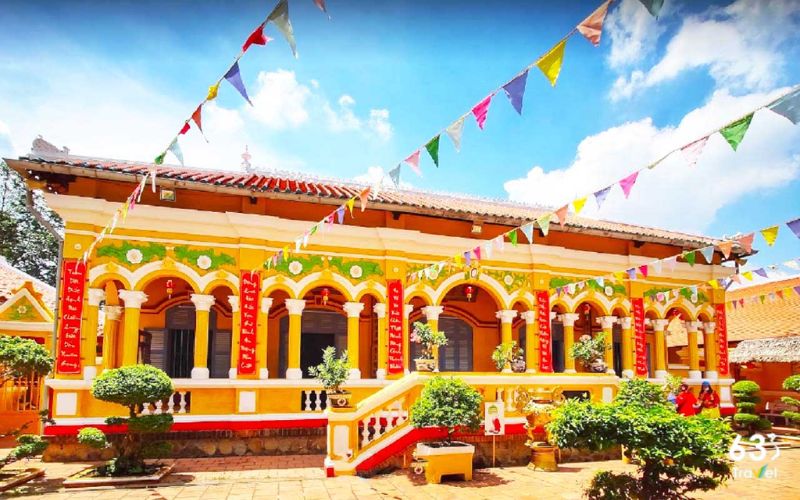
Nam Nha Pagoda - Pagoda with unique architecture in Can Tho
The main hall, also known as Dieu Tri Buu Dien, consists of five rooms with the beauty of interference between Chinese, French and Vietnamese cultures. The carved motifs inside the temple show sophistication and ingenuity. Warm yellow, symbolizing luck, covers this space.
The prominent red yin-yang tile roof, along with the majestic statue of two dragons painted with pearls on top, creates a solemn beauty. The long corridor behind the main hall is not only for receiving guests but also leads to Can Dao Duong and Kun Dao Duong, which are arranged for men and women. All create a peaceful space, inviting visitors to visit and contemplate.
Pothisomron Temple
Address: 1144 QL91, Chau Van Liem, O Mon, Can Tho.
Pothi Somron Pagoda was built in 1735, is an ancient Khmer pagoda located on the O Mon river. With more than 20 generations of abbots, this place has witnessed many ups and downs of history, including famous abbots such as Venerable Duong Pau and Venerable Dao Nhu. The pagoda was recognized as a city-level historical and cultural relic in 2006, marking the unique culture of the Khmer people.
When you arrive at the temple, you will immediately be attracted by the solemn, peaceful space. The ancient architecture blends with the green campus, bringing a feeling of peace and tranquility. The Five-Sound Music echoes in the space, along with the bustle of monks and nuns, creating a vivid picture of spiritual life.
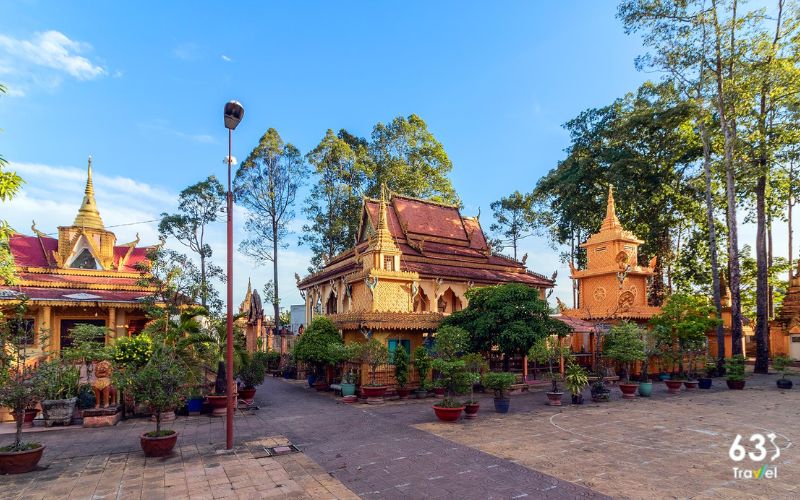
Pothisomron Pagoda - A masterpiece of ancient Khmer architecture in Can Tho
Pothi Somron Pagoda has undergone two relocations: from O Mon arch to Bo Rich and finally to its current location on Rach Chua. In the temple grounds, many trees, especially the Somron tree, have contributed to forming the name of the temple.
The main hall, a prominent building in the architectural complex, was built in the East direction, expressing the Khmer concept that even though Buddha was in the West, he always turned to the East to save sentient beings. The steps leading up to the main hall have a sophisticated statue of Buddha meditating, while on the walls are vivid paintings of the Buddha's life. Images of the fairies Kennar and the god bird Krud are carved flying, supporting the tiled roof.
The main hall's roof has three overlapping levels, with a dragon image running along the edge of the roof, its tail reaching straight up into the sky. Every detail such as columns, fences, door frames and walls are meticulously carved with geometric and water hyacinth patterns, highlighting the artistic beauty of the temple. All create a sacred space, inviting visitors to visit and experience the unique cultural values here.
Water Lily Ecological Garden
Address: National Highway 61B, Ba Lang, Cai Rang, Can Tho
Ticket price: 100,000 VND/ticket
Hoa Water Ecological Garden is an ideal destination for those who love the beauty of nature and fresh air. This place impresses with rows of coconut trees and blooming water lily ponds, creating a wonderful picture of nature. When coming to this ecological garden, you will not only participate in many interesting entertainment games but also have the opportunity to enjoy specialties with rich Western flavors.
As soon as you set foot in the Hoa Water Ecological Garden, you will immediately feel the peaceful, riverside atmosphere of the Southwest region. You will see clear blue ponds, thatched-roof houses and straight rows of areca trees. The paths in the ecological area are designed in harmony with the landscape, with carts, lovely garden corners, plank bridges and fish traps, all reminiscent of a simple childhood.
The poetic and charming space here will help you dispel all fatigue after stressful working hours, bringing peaceful moments with your family. Besides, you can also visit many other interesting places such as Tay Do Night Market, Truc Lam Phuong Nam Zen Monastery or Can Tho Noodle House.
An experience not to be missed at Hoa Sung Ecological Garden is canoeing and sightseeing. This activity is even more interesting when you go with a group of friends, rowing the canoe and stopping to take photos with the water wheel, wooden bridge... The beautiful virtual living corners here will definitely help you preserve those moments. memorable in my youth.
In addition to beautiful scenery, Hoa Water Ecological Garden also offers many other interesting activities. Relaxing fishing is one of them, where you can try your luck with fish such as catfish, snakehead fish, mallard fish... and enjoy your achievements in cozy, regional-style thatched huts. West.
Can Tho artificial beach
Address: Song Hau, Cai Khe, Ninh Kieu, Can Tho.
Sightseeing ticket price: 20,000 VND/person.
Can Tho artificial beach (also known as Can Tho beach) stretches for a beautiful 400m right at the junction of Hau river and Can Tho river. With more than 1 million cubic meters of sand added to create a clean freshwater beach, this place is an ideal destination for those who want to relax and enjoy the fresh water space. Here, you can comfortably swim, walk on the sand or admire the romantic beauty of Can Tho Bridge.
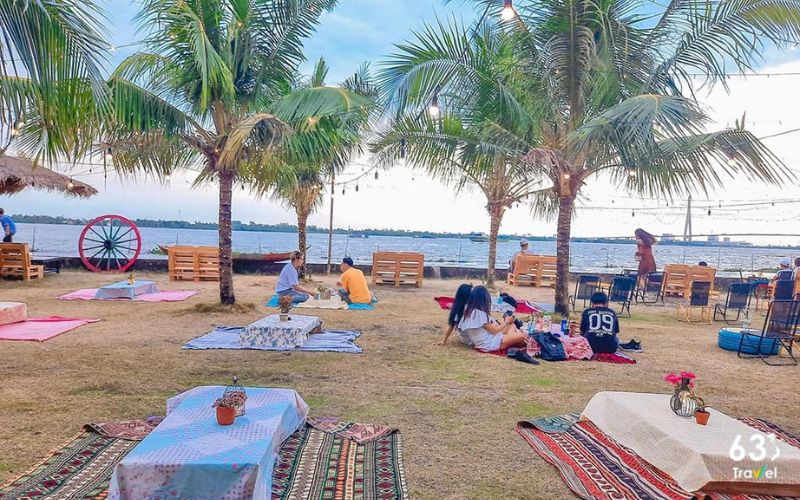
Can Tho artificial beach - A wonderful place to shine and relax
When you set foot on the beach, you will be fascinated by the vast scenery of the river and the cool and fresh atmosphere. Along the coast, the sounds of crashing waves and blowing wind create a natural symphony, mixed with images of bustling boats and fishermen working hard.
If you have once visited Can Tho artificial beach, you will certainly not forget the image of Can Tho bridge standing out from afar. This is the cable-stayed bridge with the longest main span in Vietnam and Southeast Asia, giving you a wonderful feeling when watching the sea, enjoying interesting drinks and watching the sunset slowly fall. All of these experiences will create memorable memories in your journey to explore Can Tho.
Surely the list of 26 beautiful and famous tourist destinations in Can Tho that 63Stravel has introduced above is an inspiration for your meaningful discovery journey. Don't forget to choose the ideal time to experience the beauty of this land!
Can Tho 1684 view
Update day : 23/09/2024
Can Tho always attracts tourists with its rustic and simple beauty from nature to people. To fully explore this land of Tay Do, don't forget to visit the Hoa Water Ecological Garden. Hoa Sung Ecological Garden is located right on Highway 61B (the road connecting Can Tho - Vi Thanh), Ba Lang ward, Cai Rang district, only about 5km from Can Tho city center. The garden is more than 1 hectare in size, is a garden food court, serving Southern-style country dishes, along with recreational fishing and amateur music activities that will definitely bring relaxing moments. Great for visitors. When traveling to Can Tho, coming here, you can comfortably immerse yourself in the peaceful natural scenery of the Western garden. Water Lily Ecological Garden was built with a green, airy space, rows of coconut trees full of fruit silhouetted on the water surface, bunches of water lilies shimmering on the lake surface, lush jackfruit garden laden with fruit, a truly idyllic beauty. poetic. The path system in the Hoa Sung eco-garden is meticulously invested with old bricks and occasionally you will see the image of a cart wheel in a small corner of the garden that looks extremely rustic. In the eco-garden there is also There is a plank bridge next to the bridge for visitors to enjoy the breeze, as if evoking a peaceful childhood in a Southern village. Coming to Hoa Sung Ecological Garden, visitors not only feel the fresh, cool air of the orchard but can also relax by fishing for snakehead fish, giant fish... raised in the pond. After a moment of recreational fishing, guests can ask the gardener to process the "trophies" into their favorite dishes, then enjoy them under the thatched huts. Coming here, don't forget to enjoy delicious rustic country dishes such as: fried rice husk shrimp, grilled snails with pepper, eel with cilantro, grilled garden chicken with salt and chili, braised giant fish, braised snakehead fish, catfish. grilled, grilled snakeheads, boiled or stir-fried garden vegetables... One of the unique dishes that diners find hard to miss when coming to Hoa Sung is the fish sauce hotpot served with coconut vegetables, chopsticks or water lily. The attractive point of this fish sauce hotpot is that it uses fresh coconut water available in the garden to cook, thanks to which Hoa Sung fish sauce hotpot has a sweet taste, with a very unique aroma compared to other places. Most of Hoa Sung's typical dishes are made from fish raised in ponds, vegetables and fruits grown on site, ensuring "homegrown" criteria of freshness, quality, and hygiene. food production. To make the menu more diverse, in the floating season, Hoa Sung Ecological Garden also updates dishes made from specialties of ling fish, such as: crispy fried ling fish, braised or cooked sour...
Can Tho 1677 view
From January to December
My Khanh Can Tho tourist area is located about 10km from the city center. The area of My Khanh tourist area is very spacious, up to more than 300,000 m2. This place opens up many unique spaces such as fruit gardens, ancient houses, fish ponds, canals and many interesting games. The route to My Khanh Can Tho tourist area is probably quite unfamiliar to many new visitors coming here for the first time. You can refer to the following transportation methods: By road: For tourists around the Can Tho city area, you can choose motorbikes, passenger cars, taxis... These means of transport are popular, convenient to travel and easy to control. Traveling by water: Traveling by cruise ship will definitely be a memorable experience. You can visit Cai Rang and Phong Dien floating markets, which are typical and interesting trading activities in Can Tho. If you are coming from a far away place, you should find places to stay to rest to complete your sightseeing and discovery journey. This will make your trip more meaningful by having a comfortable place to rest after hours of hard fun. The best time to visit My Khanh is from November to April next year. At that time, it was the dry season with beautiful golden sunshine, flowers and fruits were ripe with fruit gardens full of brightly colored fruits. This time is very suitable for sightseeing experiences or super beautiful scenery for you to enjoy super "virtual" check-in. The first thing to mention when introducing My Khanh Can Tho tourist area is the ancient Southern houses. The houses are all over 100 years old, built and presented according to the architectural style of ancient Southern people. Behind the ancient houses, My Khanh Can Tho tourist area also has a traditional craft village preserving the specialties of the Southern region. Visitors will be able to witness firsthand the steps of making rice paper, noodles or the process of making delicious wine. These will also be meaningful gifts for you to enjoy or buy as gifts for loved ones. Countless types of typical fruits of the West are available at My Khanh tourist garden, with all colors, each tree is laden with fruit. You will definitely be "dazzled" by the rows of mangoes, rambutans, jackfruits... planted along the path. Not only are they pleasing to the eye, you can also enjoy the delicious flavor of these fruits. What could be better than seeing and enjoying fruit right in the garden? My Khanh Can Tho tourist area is a space to enjoy Southern amateur music. These melodies are the traditional art of Cochinchina. In 2013, UNESCO recognized them as an intangible cultural heritage of humanity. Coming to My Khanh Can Tho eco-tourism area, tourists can also transform into landowners, "returning" to the ancient lifestyle with Ba Ba clothes, large houses and servants. The experience is also recreated very realistically when you travel by horse cart or wade through ditches to catch fish. My Khanh tourist village also surprises you with the bustling atmosphere of the racetracks. In particular, the grumpy piglets or cunning dogs are the main characters of the extremely thrilling and attractive contest. You can buy betting tickets for the "candidates" that you believe will reach the finish line the soonest. Besides, My Khanh Can Tho tourist area also has many attractive activities such as watching circus, fishing, watching 6D movies,... Tourists can witness impressive circus performances with their own eyes or bottle-feed the fish themselves. very interesting. It would be a pity to travel to My Khanh Can Tho and miss the culinary experience of the river region here. The dishes are all famous specialties of the Southwest river region. When coming to My Khanh Can Tho tourist area, don't forget to enjoy the specialties: grilled snakehead fish, fish sauce hotpot, noodle soup, braised perch, crab hotpot,...
Can Tho 1933 view
November to April
Lung Cot Cau tourist area is one of the ideal eco-tourism destinations for those who love rivers and gardens. Lung Cot Cau tourist area is located in Nhon Nghia commune, Phong Dien District, only about 5km from Can Tho City Center towards Vi Thanh. With a rustic natural setting, imbued with the rivers and waters of the Southwest, cool air, surrounded by fruit trees along ponds and lakes, it attracts a large number of visitors. Lung Cot Cau Tourist Area is also identified as a cultural relic of the ancient Funan Kingdom. Coming to this eco-tourism area, in addition to visiting and enjoying dishes from garden fruits and specialty dishes of the southwest, visitors also have the opportunity to learn more about the ancient Oc Eo culture. The place name Bung Da Noi - Lung Cot Cau is a name that was formed not long ago, about 20 years or so from the coincidence of people digging ditches, planting beds, finding crabs, catching fish... in the valleys. Bau, natural ditches and discovered and picked up a number of pieces of porcelain, teapots, stone statues, and pieces of gold belonging to the Oc Eo culture. When in the 1990s, the Central Institute of Archeology sent a survey team to Nhon Thanh hamlet, Nhon Nghia commune, Phong Dien district to conduct exploration and excavation. Through the results of archeology and ancient documents and bibliographies, there is enough basis to confirm that, before the Chenla (Khmer), there was once an ethnic group with a South Asian Hindu civilization and culture. , lived, settled, and disappeared on the map of the Mekong River basin for quite a long time. Thanks to excavations, archaeologists have encountered many large wooden stakes in a number of ponds and ponds around the area, at a depth of 2 to 3 m under the layer of plant alluvium. In addition, they also discovered many green, rectangular shaped rocks that had been processed, "floating" in the pond of this relic. Along with relics made of ceramic, bronze, gold, and large fossilized animal bones, experts have confirmed that under the alluvial soil of Bung Da Noi - Lung Cot Cau over 1,500 years ago, there were Phu residents. Nam Co lived in a quite prosperous community. Why this kingdom fell to this day has no satisfactory explanation. From planting a garden and digging a fish pond, the host family decided to turn this place into a rustic, ecological tourist area associated with learning about history. In particular, when coming to the floating rock - Lung Cot Cau tourist area, in addition to visiting the orchard and enjoying Southern-style dishes, visitors can also experience becoming a true Western farmer. Digging ditches to catch fish, rowing canoes to pick vegetables, digging the ground to harvest cassava and dwarf tubers... Officially put into operation in 2015, Lung Cot Cau eco-tourism area has an area of more than 7 hectares, of which most are orchards such as durian and mangosteen (mainly) and the rest are other types such as Bon bon, mango, longan, rambutan, pineapple, orange, tangerine, avocado, guava, plum, banana, grapefruit, Ha Chau strawberry and vegetables... The rest is built an amusement park centered around a Large pond with fish, this is where visitors have a comfortable space to eat, drink and play together. Lung Cot Cau tourist area is open for free, only charging fees for food and some services. Coming here, you can participate in typical rustic games of the river region such as: walking on a bamboo bridge without handrails, canoe racing, tug of war, cycling on the monkey bridge... you should rent extremely comfortable Ba Ba clothes. roof to easily participate in fun activities. Among all the activities, duck catching and fish catching are vibrant games typical of Westerners that are loved and participated in by many tourists. You will be extremely excited to chase ducks in the field and scream when you catch them, wading into the ditch and splashing water to catch snakehead fish hiding in deep mud will be extremely interesting experiences. taste. With the obtained spoils such as perch, snakehead fish, etc., the restaurant will process them into attractive dishes: grilled fish, sour fish soup with a strong Southwestern flavor that everyone must love. Not only does it attract tourists by its charming and poetic scenery, this place also has a system of water houses and resorts with light, beautiful and airy architecture for visitors to rest and comfortably eat and drink. At the tourist area, they serve rustic dishes such as grilled snakehead fish, roasted pork, steamed chicken with dwarf roots (or leaves, crab leaves), crab hotpot, country fish sauce hotpot... Especially, there is Seasonal dishes such as: stir-fried durian flowers, mangosteen salad, rambutan salad, grapefruit salad or Sesbania seaweed shrimp... The dishes are affordable and have strong flavors of the western region. Lung Cot Cau Ecotourism Area is also a place to regularly organize cultural exchange programs, amateur music competitions and art programs to celebrate major holidays.
Can Tho 1730 view
From January to December
If you have the opportunity to travel to Can Tho, remember to visit Bao Gia Trang Dien ecological garden to immerse yourself in the green Western space and enjoy the fresh air. Participate in recreational activities of fishing, rowing basket boats... and enjoy Southern specialties. Bao Gia Trang Vien Ecological Garden is located at 268 Phu Quoi Area, Thuong Thanh Ward, Cai Rang District, only 7km from Can Tho city. With an area of about 20,000 square meters, Bao Gia Trang Vien ecological garden overwhelms visitors with its unique and ancient garden. In addition to beautiful bonsai trees, this place also has tall sala trees and many hundred-year-old star fruit trees. The space is airy and poetically beautiful with water lily ponds and swimming fish. The attraction at Bao Gia Trang Vien is that there are new adventure games, such as: basket boat swimming, mountain climbing, aerial games, off-road racing... Among them, slapping ditches and catching fish is a popular activity. most loved by tourists. It was fun when the whole group got covered in mud, becoming real Western farmers catching fish hidden under the mud. Not only can you play freely and have lots of laughter, but you can also enjoy rustic Western dishes from fish you catch yourself. You can rent a ba ba shirt and bandana when participating in this game and Bao Gia Trang Bien will equip you with traditional fishing equipment that is authentic to Westerners. In particular, there is a clean vegetable garden, a melon garden (Japanese Taki variety), and Gia Lai forest vegetables for visitors to harvest and prepare dishes. The spacious campus at Bao Gia Trang Vien is suitable for organizing picnics and team games. With many diverse activities: folding coconut leaves, five-fruit tray, learning to make folk cakes, making rice paintings, learning to sing amateur music... it will definitely leave unforgettable impressions in the hearts of visitors. Bao Gia Trang Vien Ecological Garden also has a lovely homestay area with a view of the romantic river, making it an ideal place to stay for tourists.
Can Tho 1658 view
From January to December
Currently, in Can Tho city there are many garden tourist destinations, including Xeo Nhum Ecological Garden which is a favorite place for many tourists. Because this place has healthy trees and sweet fruits, the space is quiet, suitable for visitors to relax and rest after stressful working days and noisy city life. Xeo Nhum Ecological Garden is located in Hong Loan residential area, Hung Thanh ward, Cai Rang district. Just leave Can Tho, run along Highway 1A toward Soc Trang for more than two kilometers to arrive. With an area of over 2 hectares, Xeo Nhum pleases visitors with its green space of gardens, fish ponds, gardens and beautiful flower fences. The highlight of creating the Xeo Nhum ecological garden is the shady perennial longan trees, next to the cool, romantic rows of green bamboo. The scene in the garden is very poetic, idyllic, rustic with trellises of gourds, luffa, bitter melon, water docks, nets, and rowing boats familiar in Southern villages. The food area around the fishing lake is designed in an airy, quiet space. Sitting here, visitors can enjoy Western-style dishes: steamed bamboo chicken with grapefruit, mangosteen bamboo chicken salad, grilled yellow catfish young luffa salad, seafood grapefruit salad, steamed snails with bottle gourd, and cooked mackerel fish. Acorns... All are "homegrown" of Xeo Nhum, bamboo chickens are raised in the garden, fish are raised in ponds, gourds and luffa are planted in the vegetable garden. At Xeo Nhum ecological garden, you can also experience growing vegetables like a farmer. If you like, you can rent land (each plot area is 10m2, cost about 100,000 VND per month) to grow vegetables, care for them and harvest them yourself. Staff at the garden will take care of the area when visitors are not present. During harvest time, visitors just need to come pick and bring the fruits home, or they can ask the chefs here to process them on the spot into delicious dishes. In addition to the service of growing their own vegetables, visitors can dig ditches to catch fish, go fishing, hook up, catch snails... Especially and the unique mark of Xeo Nhum is the colorful homestays. The rows of colorful and lovely homestays create a very beautiful background for those who like to live virtually.
Can Tho 1635 view
From January to December
Con Au Can Tho not only attracts tourists by the beautiful scenery of nature and rivers, here, you can also experience many tourist activities and enjoy a variety of specialty dishes. This is a small island located in Hung Loi ward, Cai Rang, Can Tho. Con Au is known as one of the most beautiful islands along the romantic Hau River. The reason it is called Con Au is because, in the past, when people came to this area to live, they saw a lot of baby palm trees, so from then on they named it Con Au. Currently in Con Au there are about 70 families making a living by gardening. Therefore, when visiting Con Au, you will admire the immense green natural scenery and fresh, cool atmosphere. You can visit Con Au Can Tho at any time of the year, it is beautiful. However, before going, you should also check the weather forecast in advance to avoid sudden rains affecting your tour. Most tourists come to Con Au on weekends or holidays. So you should arrange your travel time accordingly. Experience traveling to Con Au Can Tho, to explore this place you first need to get to Can Tho by means of transport such as: Plane, bus, motorbike. For those of you living as far away as the Northern region, you can take a plane departing from Noi Bai (Hanoi) to Can Tho airport. If you are in neighboring provinces, the best way is to take a bus or motorbike to Can Tho. Con Au is about 13.7km from Can Tho center, so you can take a taxi or motorbike in the direction of National Highway 1A about 20km to reach this famous eco-tourism area. If you are not familiar with the route, you can ask local people or look up google maps. Con Au tourist area attracts tourists with the beautiful scenery typical of the Western river region and learn about the simple life of the people living here. Visiting Con Au, visitors will enjoy a memorable 'stress relief' trip on the weekend with loved ones and friends. Con Au is located at the foot of Can Tho bridge, with a total area of 130 hectares and surrounded by rustic natural scenery and vast green cork forests. Visiting the Con Au Can Tho eco-tourism area, visitors will be able to walk on cool, tree-lined streets enjoying the fresh, relaxing atmosphere. Con Au also has lush fruit gardens grown by the people here with all kinds of Western specialties such as: rambutan, custard apple, mangosteen, durian, plum, green-skinned grapefruit, toad,... If you come to Con Au early in the morning, you will witness people rushing to harvest fruits and vegetables to make it to the market early in the day. Visiting Con Au, visitors can also visit the typical mangrove forests here. If you are afraid to walk, you can rent a canoe driven by local people to weave through the canals to admire the rich natural scenery here. Besides, when you come to Con Au, you can also enjoy all kinds of fresh four-season fruits and specialties of the Western river region such as: Sesbania linden fish hotpot, banh xeo, water lily, goby fish hotpot, etc. .. In addition, Con Au Can Tho tourism also has attractive services for tourists to visit such as canoeing, fishing, digging ditches, relaxing, playing sports and learning about the rustic life of the villagers. countryside.
Can Tho 1740 view
From January to December
On the night of November 10, 1929, in a hut across the rice paddies of Co Do plantation (in Thoi Dong village, Thoi Bao canton, O Mon district, Can Tho province), comrade Ha Huy Giap - Member of the Executive Committee of the Special Committee for Security The Southern Communist Party of Hau Giang was assigned by the Special Committee to O Mon in coordination with comrade Nguyen Van Nhung and comrade Bay Nui to establish the An Nam Communist Party Cell, with comrade Ha Huy Giap as Secretary. The Annam Communist Party Cell of the Red Flag Party propagated and campaigned to raise revolutionary enlightenment for a large number of working farmers, guided the fight for their rights, and actively selected the masses to join party organizations. The Party cell quickly promoted the building and development of grassroots party organizations throughout the province to lead the revolutionary movement. The birth of this cell not only promoted the revolutionary movement in Can Tho but also had a strong impact on many localities in the region such as Dong Thap, An Giang... From the first Party cell, many other Party cells were established in the province... Mass organizations of the Party such as the Red Trade Union, the Red Agricultural Association, Youth, and Anti-Imperial Women were also organized in many places. , under the leadership of the party cells, gathered a large number of people and promoted the revolutionary struggle movement. To preserve and promote historical values, the city has invested in building a project to preserve, restore and promote the value of historical relics. Location of the establishment of the An Nam Communist Party Cell of the Red Flag Party with an area of nearly 40,000 square meters. The project was completed and put into use in 2019 right on the old plantation land, which is also the center of Co Do district today. The relic area is built in the style of an open park, with airy space, including items: monuments, reliefs, stele houses, squares, and lotus ponds. On October 31, 2013, the Ministry of Culture, Sports and Tourism decided to classify the location where the An Nam Communist Party Cell of the Red Flag was established as a national historical relic. Currently, the relic site is a place for sightseeing, studying, traditional activities, cultural and artistic activities, and sports for people of all walks of life and tourists from near and far. Source: Can Tho City People's Committee
Can Tho 2250 view
Pothi Somron Pagoda is an ancient Khmer pagoda located on the O Mon river, in Chau Van Liem ward, O Mon district, Can Tho city. The pagoda was recognized as a city-level historical and cultural relic in 2006. In the pagoda's grounds there are many trees, including a tree called Somron, so the pagoda was named Somron. Initially, in 1735, Pothi Somron Pagoda was only built with simple materials such as leaves and bamboo. By 1856, the pagoda was built with precious woods such as spokes, ca ca, Thao lao and covered with fish-scale tiles. 100 years later, the pagoda was degraded, Venerable Thach Khieng - Abbot of the pagoda from 1950 to 1988 went to Phnom Penh to request a new design from famous architects of Cambodia, on the basis of preserving traditional architecture. system. Construction on the new pagoda began in June 1950 and was completed in 1952. This architecture is kept until now. The pagoda has one side facing the gate of the Khmer Theravada Buddhist Academy, the other gate is close to the gently flowing O Mon River with a cool water wharf. The main hall is a prominent building in the architectural complex of Pothi Somron Pagoda, built in the East direction. Khmer people believe that although Buddha is in the Western world, he always looks towards the East to save sentient beings. The steps leading up to the main hall have a sophisticated Buddha statue meditating. On the wall are drawings depicting the life of Buddha presented very vividly. The images of the nymphs Kennâr and the god bird Krud are carved so high as to support the tile roof. The main hall's roof has three overlapping levels, with a dragon image running along the edge of the roof with its tail reaching straight up into the sky. The columns, fences, door frames, roof tops, and walls are all meticulously carved with geometric and water hyacinth patterns. Khmer pagodas all have core towers, but perhaps there are few pagodas that can preserve a more than 200-year-old tower like Pothi Somron Pagoda. The bone tower is right in front of the main hall, built of umbrellas, laterite, and bricks dating back to the 18th century. Inside this tower are the remains of many Buddhists and have been preserved for many generations. According to Venerable Dao Nhu, abbot of the pagoda since 1988, said: some Buddhists asked to rebuild and renew the outside of the tower, but the pagoda did not agree, because this is evidence of the pagoda's history and culture. nation's culture. The pagoda currently preserves many antiques. These are wooden swallow wings made in 1856 carved with images simulating stories about Shakyamuni Buddha, more than 100 sets of Satra sutras (leaf books), 17 wooden statues nearly 200 years old. The Buddha statue in the Center of the Main Hall was carved in 1885. During the two resistance wars against the French and the Americans, Pothi Somron Pagoda supported and sheltered many young people who escaped the military draft of the old regime. Many monks and monks of the pagoda, after returning from secular life, became party members and union members. Typical examples include Mr. Dao Sang, Chief of Police and Mr. Dao Ca, Chairman of the Dinh Mon Commune Resistance Committee in the years 1945 - 1948. For nearly three centuries of existence, the ancient temple is still dignified and pure, many monks have studied here, there are monks with high virtue and great merit, such as: Venerable Dao Nhu, practicing at Pothi Som Rom was 12 years old and became the abbot of the temple. Up to now, Venerable Dao Nhu is making great contributions to the sect and church as the new leader of the Khmer Theravada Buddhist Academy. Today, Pothi Somron Pagoda is the origin of many social and cultural activities launched by the Vietnam Fatherland Front Committee of Can Tho City, the Buddhist Association of Can Tho City and the Department of Culture, Sports and Tourism. Source: Western Travel
Can Tho 2184 view
The Can Tho Grand Prison historical relic is currently located at No. 8, Ngo Gia Tu Street, Tan An Ward, Ninh Kieu District, Can Tho City. To serve the ruling apparatus in Can Tho, from 1876 to 1886, the French colonialists promoted the construction of many agencies and offices... including a prison named "Prison Provinciale". The prison was built on an area of 3,762 square meters, adjacent to the Governor's Palace, opposite the Administrative Building and separate from the residential area, people often call it Can Tho Grand Prison. When the Geneva Agreement was signed in 1954, the Saigon government changed the name of Can Tho province to Phong Dinh province, and the Can Tho Grand Prison was renamed the Correctional Center. But no matter what name it is called, Can Tho Grand Prison is essentially a hell on earth - a place where imperialist colonialists imprison and exile our revolutionary soldiers and patriotic compatriots. The Big Examination Gate has an arch shape, on the left of the gate is the office of the on-duty supervisor, on the right is the office and residence of the chief supervisor. The large prison is surrounded by a wall from 3.6m to 5m high, covered with pieces of bottles and barbed wire. At each corner of the wall is a 6m high watchtower with guards and floodlights at night to control prisoners. Inside the large prison, there are 21 collective cells and many solitary confinement cells. Between the prison rows is a large yard for prisoners to sunbathe. In this yard, the colonialists and imperialists also built pagodas and churches to show respect for the prisoners' beliefs and religion. Around 1963, two rows of buildings were built on the yard behind the temple, the ground floor had no walls - for a time it was used as a vocational guidance house for prisoners... The prescribed capacity in each collective cell is only about 30 to 40 people, but sometimes the number of prisoners reaches 70 to 80 people. Especially after the Southern Uprising, the enemy crazy used all tricks to terrorize and take revenge on our people. Many leaders, party members and the masses were imprisoned by the French colonialists at the Can Tho Grand Prison. In addition, the enemy also brought hundreds of people participating in the uprising and leading comrades in the provinces of Soc Trang, Bac Lieu, Ca Mau... here to detain and brutally torture them. Especially during the period when US imperialism used the "Law promulgated by the Republic of Vietnam regime on May 6, 1959 to terrorize and restrain our people, arresting all those suspected of being "Viet Cong", At this time, the number of prisoners in each room sometimes reached more than 100 people. Many prisoners could not endure the regime of imprisonment, torture, and harsh food and had to slowly die in this dark prison. The remaining people were infected with all kinds of diseases: scabies, malaria, typhoid, tuberculosis... For special political prisoners, the enemy was locked up in solitary confinement cells, tortured to the point of paralysis but still alive. loyalty to the Party and the people, keeping integrity until the last breath. Despite extreme torture, the Party comrades in prison still had Party Cells, Party Committees, study activities, and organized struggles with the enemy every hour and every minute, resolutely preserving revolutionary qualities. It is the indomitable fighting spirit and patriotism of political prisoners that has inspired and enlightened the revolution by many prison guards and guards, and they volunteered to be our internal base. Inform political prisoners of our situation and the enemy outside to take precautions or have strategies to fight the enemy in prison. The South was completely liberated, and Can Tho Grand Prison became a deeply engraved evidence of the indelible crimes of colonialism and imperialism. It is here that so many outstanding people from their hometown of Can Tho and neighboring provinces have fallen to contribute to writing the glorious and heroic history of the nation. On June 28, 1996, the Ministry of Culture and Information ranked Can Tho Grand Prison as a national historical relic. Source: Can Tho tourism information portal
Can Tho 2179 view
Bui Huu Nghia Valedictorian Memorial Area is located at Huynh Man Dat Street, Bui Huu Nghia Ward, Binh Thuy District, Can Tho City. This is the resting place of Valedictorian Bui Huu Nghia - a patriotic poet, a pioneer author of Vietnamese opera theater, who was known as the four great heroes or one of the four Golden Dragons of the South. Bui Huu Nghia, nickname Nghi Chi, was born in Binh Thuy village, Vinh Dinh canton, Dinh Vien district, Vinh Tran palace (now Binh Thuy district, Can Tho city) into a poor fisherman family. In the year of the Goat (1835), he passed the Nguyen Prize (valedictorian) in the Huong Truong Gia Dinh exam, so people often called him Nghia Valedictorian. He was appointed by the Nguyen court as Tri Phuoc Chanh district, Phuoc Long district, Bien Hoa province (now Dong Nai province); then Tri district, Tra Vang district (now in Tra Vinh province). In 1848, because he defended the poor in the "Rach Lang The" case, he was falsely accused by mandarins and tycoons and sentenced to death by the court. His wife, Mrs. Nguyen Thi Ton, went to the capital Hue to appeal for her husband's injustice. Bui Huu Nghia was spared death but was exiled to guard the border of Vinh Thong (Chau Doc). In 1862, he returned from the mandarin to Long Tuyen - Can Tho to open a school to teach and treat diseases for poor people, then participated in the patriotic movement against the French colonialists. He died on January 21, 1872, at the age of 65. Valedictorian Bui Huu Nghia is a shining example of fairness, integrity, and devotion to the people and country. His famous opera Kim Thach Ky Duyen is considered the oldest in Vietnam, and has been performed all over the country. country and is also the first Vietnamese opera to be translated into French. He is one of the cultural celebrities of Can Tho who is trusted, loved and respected by the people. His name shines in the spirit of fighting against invasion, oppression, and injustice; His kindness and great contributions to the country's literature are the pride of not only the people of Can Tho but the entire Southern region. Admiring his talent and dignity, the people of Binh Thuy village took his image to worship in Binh Thuy communal house; Students set up a tablet to worship him at Nam Nha Pagoda. The Valedictorian's grave, built of laterite, has always been cared for by generations of Can Tho people and is regularly repaired and embellished. The memorial area has a campus of about 10,000 square meters with a total construction cost of more than 50 billion VND. The project was inaugurated on March 1, 2013 - the 141st anniversary of his death. The main architecture of the Relic Area is an antique style with columns about 1 meter in diameter painted reddish brown; Wooden partitions and altars are elaborately carved; Cool green tiled roof. The top of the roof is emphasized by the symbol of a pair of fish turning into a dragon, and the four corners of the roof are adorned with flying phoenix wings. Inside the memorial area there is a large, airy garden full of trees. The memorial area has four main works, including three large buildings, in which the middle is the church, the left is the exhibition house, the right is the guest house and a stele right at the entrance to summarize his talents and merits and a memorial. A number of other auxiliary works to serve tourists from near and far to visit and pay their respects. Source: Can Tho Tourism
Can Tho 2086 view
Thoi An communal house is located in Thoi Trinh A area, O Mon district, Can Tho city. Thoi An communal house was built in the early 19th century, built on a small scale by the people of Thoi Thuan hamlet, Thoi An village, using bamboo materials to worship the god. In 1852, King Tu Duc approved and conferred the title of Thoi An village communal house as "Thanh Hoang's original scene". Since the ordination, the villagers have chosen a location and joined forces to build a spacious new communal house 1km away from the old communal house. That is today's Thoi An Temple. The communal house was built in a rectangular shape, facing east, with a unique artistic architecture, imbued with the traditional architecture of the nation. Like some village communal houses in the Mekong Delta, Thoi An communal house worships "Thanh Hoang Bon Canh" who worships ancestors who openly reclaimed wasteland, established villages, and expanded the village's business. rich and prosperous; worshiping officials and soldiers who sacrificed for the country, worshiping the ancestors who taught vocational skills to the villagers. After the country was unified, the Thoi An Temple Sacrifice Committee set up an incense table to worship President Ho Chi Minh. grand. During the nine-year resistance war against French colonial invaders, Thoi An communal house was also the headquarters of the Provisional Administrative Resistance Committee of O Mon district. Every year, Thoi An people solemnly organize two festivals: Thuong Dien and Ha Dien, praying for good weather and good weather, prosperity and happiness. This is also an opportunity for people to remember heroic martyrs and those who have contributed to their homeland. Having gone through many historical events, Thoi An communal house still stands proudly. This is one of the few remaining beautiful and ancient communal houses in Can Tho City, as well as in the Mekong Delta region. With those values, on November 15, 2004, Can Tho City People's Committee ranked Thoi An communal house as a city-level historical and cultural relic. Source: Can Tho Tourism
Can Tho 2067 view
The historical site of the troop transfer location, the forward military medical station and the weapons cache on the Can Tho arc road is located in My Khanh commune, Phong Dien district, Can Tho city. Vong Cung Highway is nearly 30 km long, connecting National Highway 1A from Cai Rang bridge to Phong Dien district, mostly through communes: My Khanh, Nhon Ai, Tan Thoi, Giai Xuan and ending at Ba Se highway (Phuoc Thoi ward). , O Mon district). Right from the French colonial period, colonial henchmen suppressed and arrested people to work as road builders with a plot to build the road into a defensive belt to protect their headquarters in the inner city of Can Tho. Under the Saigon government regime, the Arc Highway continued to be built as a defensive fence to protect the tactical region IV nerve center, Tra Noc airport and US representative agencies in Can Tho. Tho is both a place to test all the most brutal tricks to wipe out revolutionary bases on the Arc Road, and at the same time serve as a springboard to attack our revolutionary forces at U Minh Base. For us, Vong Cung Highway is both a convenient gateway for roads and waterways, as well as a place to transport and supply food, weapons, necessities, and to house leaders. network for army units, creating a solid connection between the forces of the district, province and the Gathering Area to bring forces into the Arc, attacking the enemy's headquarters in Can city. Poem. During the resistance war against American imperialism, Lo Vong Cung was the place to transfer troops (My Nhon hamlet); Forward Military Medical Station (My Long hamlet); weapons hiding place (My Thuan hamlet) of revolutionary forces. Here, we organized the transportation of food, weapons, necessities to accommodate revolutionary cadres, army units and was a gathering place for revolutionary forces. Therefore, the US imperialists conducted many rounds of artillery strikes, bombarding and destroying the people's homes, fields and gardens, and spraying defoliants to destroy life, with the determination to knock the revolutionary force out of the Ring. Supply and cut communication lines between the revolutionary forces and the people here. Many battles between us and the enemy took place extremely fiercely, with countless blood and bones of soldiers and compatriots who fell on the land of the Arc. But with the tradition of patriotism and absolute belief in the revolution, the people here are not afraid of sacrifices and hardships, but are still determined to stand by, support, feed, and protect the officers and soldiers standing in the fight. fight until the day of national unification, contributing to beautifying the glorious pages of history about the revolutionary struggle tradition of the Party, army and people of Can Tho. Therefore, Can Tho Arc Road is not only a landmark but also has historical significance in Can Tho's resistance war against foreign invaders. In addition to the troop transfer location, the Forward Military Medical Station, and the place where the revolutionary forces' weapons were hidden, this place also left a deep mark of military and civil solidarity associated with the pain, loss, and sacrifice of the soldiers. compatriots and soldiers who have fallen for the Fatherland. On February 7, 2013, the Ministry of Culture, Sports and Tourism ranked the troop transfer location, the Forward Military Medical Station and the weapons hiding place on Can Tho Arc Road during the resistance war against the US as a Historical Relic. National level history. Source: Can Tho historical and cultural relics information page
Can Tho 2057 view